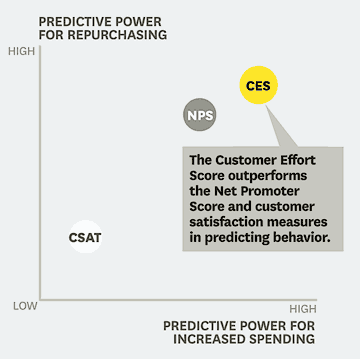
To measure your customers’ satisfaction, many indicators exist. In addition to the customer satisfaction index (CSI) and the net promoter score (NPS, see these other articles), the customer effort (CES) is very popular. In this article, I will explain in which case to use it, and what are the methods of measurement.
What is client effort?
It is simply the effort, and therefore the actions, that the customer must take to get the product or service he or she wants. The greater the number of actions, the more complex or time-consuming the tasks the client must perform, the more the indicator deteriorates.
To understand this, here is an example from e-commerce. You browse the Internet and find an object that interests you in an online store. You have never bought anything from that store previously. If you can order by simply indicating your address and payment method, the process is effortless. On the contrary if the site asks you to create an account and activate it by clicking on a link sent by email. You will find placing that order more cumbersomw. Cherry on sunday, if you know that you will never order on this site again. Your customer account will never serve you again!
On the contrary, Amazon makes your life easier with the “one-click” order. It is necessary to create an account, but with the multitude of products offered, the effort that you must invest is very quickly profitable. These are two key elements of their business model: varied offer and reduced customer effort.
Why measure client effort?
The customer effort is useful in sectors with strong competition. When the customer can switch from one product to another easily, and there is no intrinsic differentiation in the product. This is the case for all commodities markets, such as banking, insurance, online or in-store commerce, and mobile telephony.
The customer effort can become your strategy of differentiation. You can use it as the vector of attraction of your brand: “I do business with X, because it’s easy. “
In a 2010 study, “Stop trying to delight your customers“, the Harvard Business School has shown that the CES is a little better than the NPS in predicting recurring buying behavior, as well as increased client spending. The study recommends no longer trying to delight consumers, but to simplify their lives.

- CES = Customer Effort Score
- NPS = Net Promoter Score
- CSAT = Customer Satisfaction
How to measure client effort ?
You have two ways to measure the effort of your customers:
- Asking them in a survey: “On a scale of 1 to 5, how much effort did you spend to complete your transaction?” Or “Do you agree with the following statement: Is it easy to buy a product with XYZ? “
- By counting the number of clicks, calls, the time spent by your customers carrying out their transactions with you.
Within the same organization, customer effort can vary depending on the services offered or the type of transaction. A Pareto chart can help you to determine the most frequent transactions. A value chain map, the key steps in your processes.

To sustain your organization, you will need to pay attention and reduce the effort required to your customers. They will only be more satisfied, and will buy more and more often your products or services.
